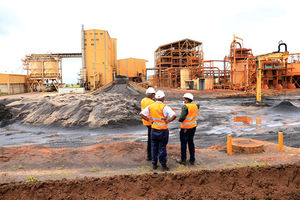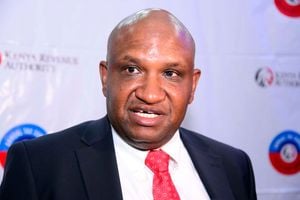
Ministry of Mining Principal Secretary Elijah Mwangi in an interview at his office at Upperhill, Nairobi on January 30, 2024.
Kenya’s mineral exports have been steadily growing over the years to Sh59 billion last year, even as the government says it has discovered 56 industrial and 14 strategic mines.
And since last October when a moratorium on licensing mining firms was lifted, the State has received over 1,417 applications of different categories of the gems from both local and foreign investors.
The phased out lifting of the ban concerns gold, manganese, titanium, gemstone, diorite , dolerite , granite granitoids , gravel, rrey whacke, grits, gneisses, Kunkar, Laterite, migmatites, phyllite, phonolite, pyroclastics, quartzite, rhyolite and sandstone among others.
“Until June 2023, the revenue from mining exports stood at approximately Sh52 billion, attracting royalties of about Sh3.7 billion. The government believes that by promoting value-addition locally, the export value can increase significantly—potentially tenfold,” Mining Principal Secretary Elijah Mwangi told Saturday Nation.
"We feel that if we do value addition locally, the value of export can go up significantly. If we do minerals processing locally, the value of revenue to the government can go up, and we have a target of Sh10 billion with 18,000 jobs to be created. The investment attracted will be Sh118 billion from construction minerals and Sh187 billion on strategic minerals,” he noted.
A nationwide geological survey whose findings were released last year identified 970 mineral throughout the country.
The government has been undertaking the next phase which is to establish the nature and viability of these stones before taking the next step.
Arising from these survey, strategic minerals that Kenya is exploring encompass a range of crucial elements vital for various industries. These include radio-active minerals such as Uranium and Thorium, essential for nuclear applications.
Cobalt, Tantalum, and Lithium are recognised for their significance in the production of batteries, particularly for electric vehicles and electronic devices.
Coltan, Niobium, Copper, Nickel and Graphite hold strategic importance in diverse industrial applications, from electronics to energy storage.
Others are Beryllium, Tsavorite, Chromite, and Rare Earths, which are vital in aerospace, jewelry and high-tech manufacturing.
Limestone, marble, gypsum, pozzolana, and fluorite, are minerals essential for construction and building materials.
Heavy mineral sands, dolomite, feldspar, and refractory clay such as kaolin find applications in both construction and industrial sectors. Granite, granitoids, gravel, grey whacke, grits, gneisses, and other geological formations serve as valuable materials for construction projects.
According to the PS the country is on the throes of unlocking its immense mining potential, boasting a treasure trove of largely underexplored and underexploited mineral resources.
The nation is in the early stages of exploration, with known deposits that span a wide range of valuable minerals such as soda ash, fluorspar, titanium, rare earth, gold, coal, manganese, iron ore, gypsum, carbon dioxide, diatomite, chromite, silica sand, limestone, and ornamental stone, among others,” Mr Mwangi explained.
Kenya’s mineral endowment is highlighted by significant deposits with Mrima Hill in Kwale county emerging as a focal point.
This location is rich in rare earth and niobium ranking among the top five global rare earth deposits.
“Mirima Hill is rich in rare earths whose value is estimated to exceed Sh8 trillion. The potential for economic growth and development from the exploitation of these resources is substantial,” said the PS.
In Kitui county, the Mui Basin holds promise as a significant source of coal, estimated to be over 400 million tonnes. Despite its vast potential to drive industrial growth, coal mining has faced stiff opposition.
Concerns regarding its environmental impact and contributions to climate change have hindered the exploitation of this fuel.

Cabinet Secretary for Mining, Blue Economy and Maritime Affairs Salim Mvurya
Acknowledging the global shift towards sustainable practices and green technologies, the PS noted that the country has a growing demand for minerals crucial to the green transition, including rare earths and radioactive materials. By recognising the strategic importance of these minerals, the country is planning to issue mining licenses on a case-by-case basis.
"We appreciate where the country is going with technology. The moment the world is going green, there is a high demand for the green transition, and these minerals include rare earths and radioactive materials. Because these are strategic minerals, we are planning that the licenses will be a case by case," stated Mr Mwangi.
The PS regretted the ministry's lack of a robust system to monitor local sales, attributing the difficulty to the fact that most local consumers are cement manufacturers who not only utilise minerals from their own mining sites but also hold mineral rights.
“We have recognised the need for a comprehensive system to monitor local mineral sales that’s why we introduced the cement levy—a royalty charge on minerals consumed in the production of cement,” said Mr Mwangi.
The cement levy is a strategic move to regulate the consumption of minerals by cement makers and to establish a revenue stream that reflects the actual usage of minerals, added the PS.
Having passed the Minerals Processing and Value Addition Policy, Kenya aims to prioritise local processing over exporting unprocessed ores.
The government has given preference to copper, coltan, nickel, and graphite, along with rare earths.
“We are aware of the locations where copper is present, and we consider ourselves fortunate to have identified coltan occurrences in six counties. To assess the feasibility of mining in these areas, we have dispatched a team from the state department to evaluate the local population's needs and concerns,” said the PS.
The most recent prospecting license covered an area of 136 square kilometers in the Vanga region, near the Kenya-Tanzania border of Lunga Lunga. This license, approved by the Mineral Rights Board, was issued in December 2018.
In the previous year, the total value of minerals produced in the country saw a significant increase of 33 percent, rising from Sh22.7 billion in 2020 to Sh30.2 billion.










